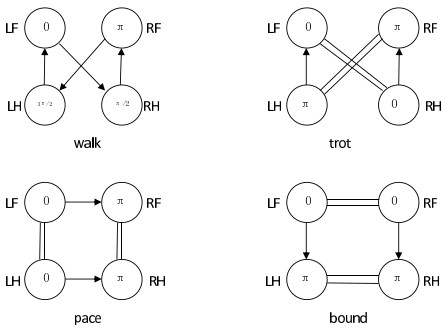In this paper, Van Der Pol (VDP) oscillators are used as the output signal of central pattern generator (CPG), and a VDP-CPG network system of quadruped with four primary gaits (walk, trot, pace and bound) is established. The existence conditions of Hopf bifurcations for VDP-CPG systems corresponding to four primary gaits are given, and the coupling strength ranges between oscillators for four gaits are obtained. Numerical simulations are used to support theoretical analysis.
1.
Introduction
Non-tuberculous mycobacteria (NTM)-induced nodules following botulinum toxin injections are increasingly being reported [1]–[3]. These infections often present as persistent nodules, which can be challenging to diagnose and manage [3]–[5]. This report presents a rare case of Mycobacterium chelonae-induced granulomatous nodules following botulinum toxin injections and includes a comprehensive review of the literature on NTM infections specifically related to botulinum toxin procedures. The aim is to highlight the importance of accurate diagnosis, appropriate antimicrobial therapy, and to provide an overview of reported cases to inform clinical practice.
2.
Case presentation
A 35-year-old healthy male presented with multiple tender and painful nodules localized at injection sites on the forehead and periorbital areas. These nodules appeared three weeks after receiving Onabotulinum toxin injections from an untrusted provider. Initially, the patient was treated with oral steroids by his initial provider without any improvement. On examination, the nodules were tender and erythematous, confined to the injection sites, and no lymphadenopathy was observed (Figure 1a,b). Empiric antibiotic therapy with oral ciprofloxacin 500 mg twice daily and clindamycin 900 mg daily was initiated to cover potential bacterial infections. However, there was no improvement after three days of treatment. A biopsy was performed on the largest nodule. The specimen was sent for histopathology to rule out mycobacterial infection or sarcoidosis. Additional samples were sent for mycobacterial, bacterial, and fungal cultures, along with NTM PCR testing. Histopathological analysis revealed interstitial granulomatous inflammation with mild necrosis, indicative of a suppurative granuloma (Figure 1c). NTM PCR confirmed the presence of Mycobacterium chelonae. Antimicrobial susceptibility testing was performed, showing no resistance. Based on the diagnosis of NTM-induced granulomatous nodules, the patient was started on a combination therapy of oral clarithromycin 500 mg, levofloxacin 500 mg, and trimethoprim/sulfamethoxazole 160 mg/800 mg, all administered twice daily for six months. Significant improvement was noted six weeks into the therapy, with total remission observed at four months. At an eight-month follow-up, the patient showed no signs of relapse.
3.
Discussion
A comprehensive review of the literature identified eight reported cases of botulinum toxin-induced granulomatous nodules attributed to NTM infection. The key characteristics of these cases are summarized in Table 1.
3.1. Demographics and clinical presentation
The eight cases involved female patients with a mean age of 38 years. Six cases were associated with botulinum toxin injections for wrinkle treatment, while two cases were related to injections for masseter hypertrophy. The nodules typically appeared an average of 20 days post-injection and were characterized by painful, erythematous, and violaceous lesions, with some cases progressing to abscess formation [1]–[7].
3.2. Histopathological and microbiological findings
Of the eight cases, six underwent biopsy, which revealed suppurative granulomas [1]–[4],[6],[7]. In the remaining two cases, a biopsy was not performed due to positive culture results [1],[2]. All isolated organisms were identified as NTM. Specifically, five cases were caused by Mycobacterium abscessus [2]–[5], one case by Mycobacterium immunogenum [7], and one case was culture and PCR-negative but treated empirically based on strong clinical and histological suspicion [6]. One case presented with acid-fast positive bacilli on histology, but the specific NTM species was not identified [1]. Notably, nodules caused by M. abscessus appeared between 4 to 10 days post-injection, while the nodule due to M. immunogenum emerged 3.5 months after the procedure [2]–[5],[7].
To date, no previous cases of M. chelonae associated with botulinum toxin-induced granulomatous nodules have been reported in the literature. The identification of this organism in our case thus represents the first documented instance of M. chelonae as an etiological agent in such a context.
3.3. Management
In patients presenting with nodules after botulinum toxin injections, initial management can include oral antibiotics and topical treatments [8],[9]. It is crucial to avoid starting oral steroids empirically due to the high risk of infectious nodules compared to non-infectious ones. Biopsy remains the gold standard for determining the etiology of the nodule. If the nodule is found to be inflammatory, such as in sarcoidal nodules, systemic steroids along with immunosuppressive agents may be administered [8],[10]–[14]. However, if the histology shows suppurative or necrotic features, NTM infection should be ruled out using special stains, cultures, and PCR [9].
3.4. Treatment
For infectious granulomas with positive NTM PCR or culture results, treatment should be tailored according to antibiotic sensitivity profiles. Since M. abscessus is the most frequently isolated organism and is known for its rapid growth and high resistance rates, combination therapy involving at least two antimicrobial agents is recommended for a duration of 4 to 6 months. Preferred treatments include a macrolide, such as clarithromycin, paired with agents like amikacin, levofloxacin, cefoxitin or tigecycline [15]–[17].
In the single case involving M. immunogenum, successful treatment was achieved with clarithromycin 500 mg twice daily for six months [7]. Antimicrobial therapy alone led to complete remission in five cases, though post-inflammatory hyperpigmentation (PIH) was noted in three instances [1],[2]. When antimicrobial therapy proved insufficient, surgical excision or debridement was performed in three cases, despite the higher risk of scarring associated with these procedures [2],[4],[5].
Given that negative cultures and PCR results are not uncommon in NTM infections, it is crucial to consider NTM infection as a potential cause of suppurative granulomas with negative test results. For cases with strong clinical and histological suspicion, multiple specimens should be tested through culture and PCR if initial tests are negative. Alternatively, empirical treatment can be initiated based on clinical and histological findings [15],[16]. This approach was exemplified by Thanasarnaksorn et al., who achieved full remission with a six-month regimen of clarithromycin and levofloxacin despite initial negative test results [6].
4.
Conclusion
This case, along with the review of the literature on NTM infections following botulinum toxin injections, underscores the necessity for clinicians to consider NTM infections in patients presenting with persistent nodules post-procedure, particularly when initial treatments fail. This is the first reported case of M. chelonae as the etiological agent in such a context. To prevent such infections, it is crucial for patients to seek treatment from trusted and licensed providers who use authentic products and perform procedures in sterile environments.
Use of AI tools declaration
The authors declare they have not used Artificial Intelligence (AI) tools in the creation of this article.










 DownLoad:
DownLoad:







